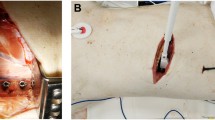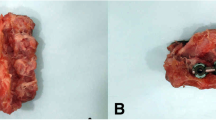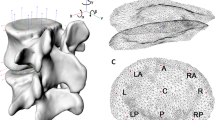Abstract
There has been few studies focusing on the disc pressure of the upper thoracic spine and it still lacks the quantitative pressure measurement of each spinal disc segment. The aim of this study was to study the pressure changes of intervertebral disc in porcine upper thoracic spine using pressure-sensitive film. Twelve porcine thoracic motion segments were harvested and successively loaded with vertical loads of 100 N, 150 N, and 200 N during 5° of anterior flexion, 5° of posterior extension and 5° of lateral bending. The resulting pressure values were measured. During anterior flexion, the anterior annulus of all segments at all loads showed higher mean pressure values than those during vertical compression, whereas the posterior annulus did not show higher mean values. During posterior extension, the anterior annulus of all segments showed lower mean pressure values than those during vertical compression, whereas the posterior annulus did not show lower mean pressure values. During lateral bending, the annulus of all segments showed higher mean pressure values than those during vertical compression. The posterior thoracic vertebra plays an important role in the motion of the upper thoracic vertebral segment and pressure distribution. During lateral bending, the concave side pressure of the annulus increases obviously, suggesting that asymmetrical force is a contributory factor for scoliosis progression.







Similar content being viewed by others
References
Shakil H, Iqbal ZA, Al-Ghadir AH (2014) Scoliosis: review of types of curves, etiological theories and conservative treatment. J Back Musculoskelet Rehabil 27:111–115
Lowe TG, Edgar M, Margulies JY, Miller NH, Raso VJ, Reinker KA, Rivard CH (2000) Etiology of idiopathic scoliosis: current trends in research. J Bone Joint Surg (Am Vol) 82:1157–1168
Gorman KF, Julien C, Moreau A (2012) The genetic epidemiology of idiopathic scoliosis. Eur Spine J 21:1905–1919
de Seze M, Cugy E (2012) Pathogenesis of idiopathic scoliosis: a review. Ann Phys Rehabil Med 55:128–138
Perdriolle R, Becchetti S, Vidal J, Lopez P (1993) Mechanical process and growth cartilages. Essential factors in the progression of scoliosis. Spine (Phila Pa 1976) 18:343–349
Stokes IA, Iatridis JC (2004) Mechanical conditions that accelerate intervertebral disc degeneration: overload versus immobilization. Spine (Phila Pa) 29:2724–2732
Neidlinger-Wilke C, Galbusera F, Pratsinis H, Mavrogonatou E, Mietsch A, Kletsas D, Wilke HJ (2014) Mechanical loading of the intervertebral disc: from the macroscopic to the cellular level. Eur Spine J 23(Suppl 3):S333–S343
Edwards WT, Ordway NR, Zheng Y, McCullen G, Han Z, Yuan HA (2001) Peak stresses observed in the posterior lateral anulus. Spine (Phila Pa 1976) 26:1753–1759
McMillan DW, McNally DS, Garbutt G, Adams MA (1996) Stress distributions inside intervertebral discs: the validity of experimental "stress profilometry'. Proc Inst Mech Eng 210:81–87
Nachemson AL, Disc pressure measurements. Spine (Phila Pa 1976) 1981; 6:93–107.
Gay RE, Zhao KD, Ilharreborde B, Bridges J, An K-N (2006) The reliability of intradiscal stress profilometry in cadaveric lumbar discs. J Musculoskelet Res 10:163–171
Xu G, Fu X, Du C, Ma J, Li Z, Tian P, Zhang T, Ma X (2014) Biomechanical comparison of mono-segment transpedicular fixation with short-segment fixation for treatment of thoracolumbar fractures: a finite element analysis. Proc Inst Mech Eng 228:1005–1013
Germaneau A, Saget M, Vendeuvre T, Doumalin P, Dupre JC, Bremand F, Hesser F, Maxy P, Rigoard P (2014) Biomechanical analysis of spinal instrumentation systems dedicated to stabilise thoracolumbar fractures: comparison between standard open surgical instrumentation and percutaneous techniques. Comput Methods Biomech Biomed Eng 17(Suppl 1):72–73
O'Connell GD, Jacobs NT, Sen S, Vresilovic EJ, Elliott DM (2011) Axial creep loading and unloaded recovery of the human intervertebral disc and the effect of degeneration. J Mech Behav Biomed Mater 4:933–942
Panagiotacopulos ND, Pope MH, Bloch R, Krag MH (1987) Water content in human intervertebral discs. Part II. Viscoelastic behavior. Spine (Phila Pa 1976) 12:918–924
Jiang Y, Sun X, Peng X, Zhao J, Zhang K (2017) Effect of sacral slope on the biomechanical behavior of the low lumbar spine. Exp Ther Med 13:2203–2210
Anderson DE, Mannen EM, Tromp R, Wong BM, Sis HL, Cadel ES, Friis EA, Bouxsein ML (2018) The rib cage reduces intervertebral disc pressures in cadaveric thoracic spines by sharing loading under applied dynamic moments. J Biomech 70:262–266
Zhang H, Hu X, Wang Y, Yin X, Tang M, Guo C, Liu S, Wang Y, Deng A, Liu J, Wu J (2013) Use of finite element analysis of a Lenke type 5 adolescent idiopathic scoliosis case to assess possible surgical outcomes. Comput Aided Surg 18:84–92
Rohlmann A, Zander T, Burra NK, Bergmann G (2008) Flexible non-fusion scoliosis correction systems reduce intervertebral rotation less than rigid implants and allow growth of the spine: a finite element analysis of different features of orthobiom. Eur Spine J 17:217–223
Lafage V, Dubousset J, Lavaste F, Skalli W (2004) 3D finite element simulation of Cotrel-Dubousset correction. Comput Aided Surg 9:17–25
Carrier J, Aubin CE, Villemure I, Labelle H (2004) Biomechanical modelling of growth modulation following rib shortening or lengthening in adolescent idiopathic scoliosis. Med Biol Eng Comput 42:541–548
Rohlmann A, Richter M, Zander T, Klockner C, Bergmann G (2006) Effect of different surgical strategies on screw forces after correction of scoliosis with a VDS implant. Eur Spine J 15:457–464
Healy AT, Lubelski D, Mageswaran P, Bhowmick DA, Bartsch AJ, Benzel EC, Mroz TE (2014) Biomechanical analysis of the upper thoracic spine after decompressive procedures. Spine J 14:1010–1016
Little AS, Brasiliense LB, Lazaro BC, Reyes PM, Dickman CA, Crawford NR (2010) Biomechanical comparison of costotransverse process screw fixation and pedicle screw fixation of the upper thoracic spine. Neurosurgery 66:178–182, (discussion 182)
Adams MA, McNally DS, Dolan P (1996) 'Stress' distributions inside intervertebral discs. The effects of age and degeneration. J Bone Joint Surg Br 78:965–972
Yildiz KI, Isik C, Tecimel O, Cay N, Firat A, Akmese R, Bozkurt M (2013) Use of contact pressure-sensitive surfaces as an indicator of graft tension in medial patellofemoral ligament reconstruction. Arch Orthop Trauma Surg 133:1657–1663
Yao QQ, Zheng SN, Cheng L, Yuan P, Zhang DS, Liao XW, Xu Y, Wang LM (2010) Effects of a new shape-memory alloy interspinous process device on pressure distribution of the intervertebral disc and zygapophyseal joints in vitro. Orthopaedic Surg 2:38–45
Kim S, Carl Miller M (2016) Validation of a finite element humeroradial joint model of contact pressure using fuji pressure sensitive film. J Biomech Eng 138(1):014501
Petersen SA, Bernard JA, Langdale ER, Belkoff SM (2016) Autologous distal clavicle versus autologous coracoid bone grafts for restoration of anterior-inferior glenoid bone loss: a biomechanical comparison. J Shoulder Elbow Surg 25:960–966
Cil A, Yazici M, Daglioglu K, Aydingoz U, Alanay A, Acaroglu RE, Gulsen M, Surat A (2005) The effect of pedicle screw placement with or without application of compression across the neurocentral cartilage on the morphology of the spinal canal and pedicle in immature pigs. Spine (Phila Pa 1976) 30:1287–1293
Zhang H, Sucato DJ (2008) Unilateral pedicle screw epiphysiodesis of the neurocentral synchondrosis. Production of idiopathic-like scoliosis in an immature animal model. J Bone Joint Surg (Am Vol) 90:2460–2469
Yazici M, Pekmezci M, Cil A, Alanay A, Acaroglu E, Oner FC (2006) The effect of pedicle expansion on pedicle morphology and biomechanical stability in the immature porcine spine. Spine (Phila Pa 1976) 31:E826–E829
Zhang Z-M, Su F, Zhang C-L, Ma P-P, Zhang Y, Zhang X-P (2013) The effect of different lumbar segmental fixation on lumbar activity and intervertebral pressure. Chongqing Yi Xue 42:3403–3404
McAfee PC, Yuan HA, Fredrickson BE, Lubicky JP (1983) The value of computed tomography in thoracolumbar fractures. An analysis of one hundred consecutive cases and a new classification. J Bone Joint Surg (Am Vol) 65:461–473
Adams MA, May S, Freeman BJ, Morrison HP, Dolan P (2000) Effects of backward bending on lumbar intervertebral discs. Relevance to physical therapy treatments for low back pain. Spine (Phila Pa 1976) 25:431–437
Steffen T, Baramki HG, Rubin R, Antoniou J, Aebi M (1998) Lumbar intradiscal pressure measured in the anterior and posterolateral annular regions during asymmetrical loading. Clinical Biomech (Bristol, Avon) 13:495–505
Mente PL, Stokes IA, Spence H, Aronsson DD (1997) Progression of vertebral wedging in an asymmetrically loaded rat tail model. Spine (Phila Pa 1976) 22:1292–1296
Stokes IA, Aronsson DD (2001) Disc and vertebral wedging in patients with progressive scoliosis. J Spinal Disord 14:317–322
Stokes IA, Spence H, Aronsson DD, Kilmer N (1996) Mechanical modulation of vertebral body growth Implications for scoliosis progression. Spine (Phila Pa 1976) 21:1162–1167
Mente PL, Aronsson DD, Stokes IA, Iatridis JC (1999) Mechanical modulation of growth for the correction of vertebral wedge deformities. J Orthop Res 17:518–524
Acknowledgements
We thank Changlin Han for providing experiment site and biomechanical test machine.
Funding
The study was approved by the Key Project of Medical Scientific Research of Hebei Province (No. 20180611) and Key Research and Development Plan of Hebei Province (No. 18277745D). The funder had no role in study design, data collection and analysis, decision to publish, or preparation of the manuscript.
Author information
Authors and Affiliations
Corresponding author
Ethics declarations
Conflict of interest
The authors declare that they have no conflict of interest.
Ethical approval
The experimental tests on animals were in compliance with the requirements of the Ethics Committee of the Children's Hospital of Hebei Province.
Additional information
Publisher's Note
Springer Nature remains neutral with regard to jurisdictional claims in published maps and institutional affiliations.
Rights and permissions
About this article
Cite this article
Meng, Z., Wang, C., Guo, X. et al. Analysis of the disc pressure of the upper thoracic spine using pressure-sensitive film: an experimental study in porcine model—implications for scoliosis progression. Australas Phys Eng Sci Med 42, 1069–1079 (2019). https://doi.org/10.1007/s13246-019-00804-y
Received:
Accepted:
Published:
Issue Date:
DOI: https://doi.org/10.1007/s13246-019-00804-y




